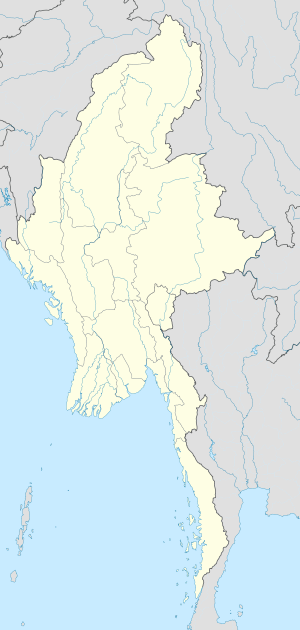Shwenyaungbin
Shwenyaungbin, also Shwe-nyaung-bin or Schwenyaungbiri, is a large village in Mogok Township, Pyin Oo Lwin District, in the Mandalay Region of central Burma. It is located west of Mogok.[1][2] It lies at a meander on the Kin River and the National Highway 31 (Tonga Road), which connects it to Kyatpyin and Mogok in the east.[3][4]
Shwenyaungbin | |
|---|---|
Village | |
 Shwenyaungbin Location in Burma | |
| Coordinates: 22°55′49″N 96°18′51″E | |
| Country | |
| Region | Mandalay Region |
| District | Pyin Oo Lwin District |
| Township | Mogok Township |
| Time zone | UTC+6.30 (MST) |
History
Historically during the Sino–Burmese War (1765–1769), the Qing army in 1769 built a massive stockade (described as being "as big as a city"[5]) at Shwenyaungbin until Maha Thiha Thura took the offensive.[6] The Burmese successfully attacked one of the walls of the fortress and in the end they agreed to a Peace Treaty with the Chinese.[7]
Seventh-day Adventist missionaries once had a station in Shwenyaungbin but missionaries such as Chit Maung and his wife and several others were driven out due to religious conflict in the region.[8]
On October 22, 1976, the village was attacked by the Kachin Independence Army and were reported to have killed 11 people and wounded others during their retreat from the Waingmaw area. [9] A private of the 253rd Battalion surrendered at Shwenyaungbin camp, three new recruits of the 3rd Battalion surrendered at Bhamo garrison and another of the 3rd Battalion at Washawng.[10]
Economy
Shwenyaungbin is part of the Ruby Mines District of the Mogok valley which is renowned for its ruby and sapphire mining. It contains a post office, a police station in the village circle and a public works department.[11][12]
Wildlife
Shwenyaungbin lies in a hilly area, rich with wildlife. Elephant inhabit the jungle to the west of the village, rhinoceros in the hills to the north, and barking deer, tigers, leopard, bear, wild pig, pheasant, peacock and partridges have also been sighted in the area.[13]
References
- Google Maps (Map). Google.
|access-date=requires|url=(help) - Bing Maps (Map). Microsoft and Harris Corporation Earthstar Geographics LLC.
|access-date=requires|url=(help) - Imperial gazetteer of India: provincial series. Superintendent of Government Printing. 1908. p. 151. Retrieved 3 January 2011.
- Oconnor, V. C. Scott (November 2006). The Silken East. Lightning Source Inc. p. 763. ISBN 978-1-4067-3402-7. Retrieved 3 January 2011.
- The Cambridge History of India. CUP Archive. 1962. p. 516. GGKEY:96PECZLGTT6. Retrieved 3 January 2011.
- Scott, Sir James George (1921). Burma: a handbook of practical information. D. O'Connor. p. 188. Retrieved 3 January 2011.
- Whiting, Marvin C. (17 April 2002). Imperial Chinese Military History: 8000 Bc – 1912 Ad. iUniverse. p. 481. ISBN 978-0-595-22134-9. Retrieved 3 January 2011.
- Spalding, Arthur Whitefield (1962). Origin and history of Seventh-Day Adventists. Review and Herald Pub. Association. p. 315. Retrieved 3 January 2011.
- Asian almanac. s.n. 1976. p. 7676. Retrieved 3 January 2011.
- British Broadcasting Corporation. Monitoring Service (1987). Summary of world broadcasts: Far East. Monitoring Service of the British Broadcasting Corp. Retrieved 3 January 2011.
- Ruby Mines District. Supt., Govt. Print. and stationery. 1962. Retrieved 3 January 2011.
- Scott, Sir James George; Hardiman, John Percy (1983). Gazetteer of Upper Burma and the Shan states. AMS Press. Retrieved 3 January 2011.
- Geological Survey of India (1953). Memoirs of the Geological Survey of India. Published by the order of the Governor-General of India. p. 9. Retrieved 3 January 2011.